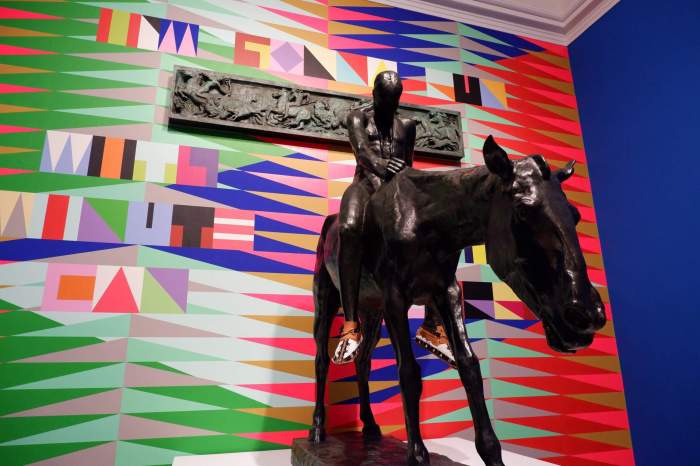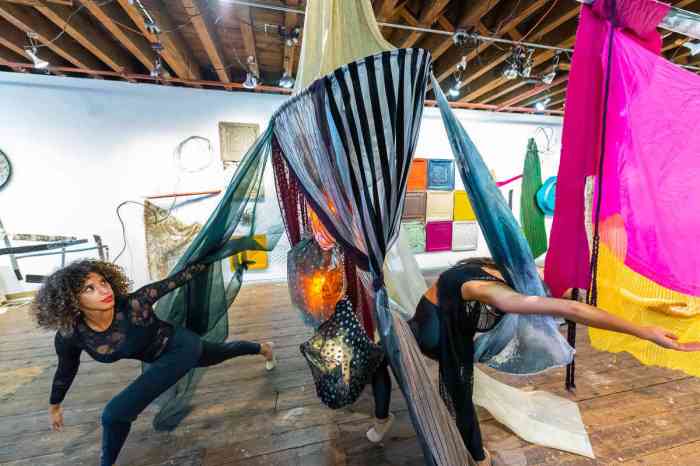Update: In response to health concerns about the novel coronavirus, the Brooklyn Museum will be closed until further notice. See the Museum’s website for updates.
Hustle to the Brooklyn Museum!
A sprawling new exhibit chronicles the brief, lavish life of the most famous nightclub of the disco era. “Studio 54: Night Magic,” opening tomorrow at the Brooklyn Museum, details how the extravagant Manhattan lounge transformed the city, becoming a haven for celebrities, artists, and society’s most extravagant and marginalized, according the show’s curator.
“At a time of economic crisis, Studio 54 helped New York City to rebrand its image, and set the new gold standard for a dynamic night out,” said Matthew Yokobosky. “Today the nightclub continues to be a model for social revolution, gender fluidity, and sexual freedom.”
The show details the 33-month lifespan of the glitzy nightspot, from April 26, 1977, to February 2, 1980 through more than 650 objects, including fashionable outfits, photographs, film, music, and disco decor, all set against the upbeat music of the era.

Brooklyn-born entrepreneurs Ian Schrager and Steve Rubell founded Studio 54 in a former opera house, installing a state-of-the-art sound system and lighting rig that quickly attracted celebrities like Andy Warhol, Mick Jagger, Elizabeth Taylor, and Michael Jackson.
The exhibit showcases a few of the club’s most iconic moments, including Bianca Jagger’s birthday party, where she saddled up on a white horse on the dance floor, and the venue’s first New Year’s Eve party, which featured model and singer Grace Jones, flanked by a dozen half-naked dancers, performing for the city’s biggest names.

The story of the club is laid out in chronological order, but a central space, dubbed “The Studio 54 Experience,” pays tribute to the many themed events that greeted those who could make it past the velvet rope, said Yokobosky.
“The entrance hall was decorated with the theme of the evening,” he said. “For example, if you went to the ‘Grease’ afterparty, they would line the hallway with lockers and were offering pomade to everybody.”
The installation features film clips from the parties, along with themed outfits, and a lighting system that glitters and flashes above. The exhibit also showcases the glamorous attire partygoers wore, designed by fashion houses Calvin Klein, Yves Saint Laurent, and Fiorucci, along with a 62-carat sapphire necklace actress Elizabeth Taylor donned to the club.
The party came to crashing halt in 1980, when the feds convicted Schrager and Rubell of felony tax evasion. The pair spent more than a year behind bars, according to a New York Times report.

In 2017, President Obama pardoned Schrager, who has since gone on to become a hotelier and real estate developer.
Rubell passed away after years of battling AIDS in 1989, and the exhibit includes a section honoring the numerous people associated with Studio 54 who died from the illness.
The club continues to influence nightlife, fashion, arts and culture to this day, according to Yokobosky.
“Studio 54 has come to represent the visual height of disco-era America: glamorous people in glamorous fashions, surrounded by gleaming lights and glitter, dancing ‘The Hustle’ in an opera house,” he said.
“Studio 54: Night Magic” at the Brooklyn Museum [200 Eastern Parkway at Washington Avenue in Prospect Heights, (718) 638-5000, www.brooklynmuseum.org]. March 13–July 5. $25–$35.























